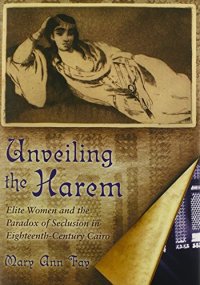
Ebook: Unveiling the Harem: Elite Women and the Paradox of Seclusion in Eighteenth-Century Cairo
Author: Mary Fay
- Tags: Egypt, Middle East, History, Women in History, World, History, Women in Islam, Islam, Religion & Spirituality, Women’s Studies, Abortion & Birth Control, Feminist Theory, History, Motherhood, Women Writers, Politics & Social Sciences
- Series: Middle East Studies Beyond Dominant Paradigms
- Year: 2012
- Publisher: Syracuse University Press
- Language: English
- pdf
There is a long history in the West of representing Middle Eastern women as uniformly oppressed by Islam, by Islamic law, and by men. Stereotypical views of Middle Eastern women today maintain that they are without legal rights, do not attend universities or have jobs outside their homes, and are not full citizens of their countries because they cannot vote or hold public office. Similar misinformation circulated in the eighteenth century when European male travelers to Egypt, documenting their observations, depicted harem women as sexual objects, deprived of autonomy, and held captive by their husbands. Fay’s Unveiling the Harem offers a persuasive corrective to this distorted view of Middle Eastern women.
Instead of the odalisque of nineteenth-century painting and the fevered imaginings of European travelers, historical research reveals that elite women in powerful, wealthy households exercised their rights under Islamic law, property rights in particular, to become owners of lucrative real estate in Cairo as well as influential members of their families and the wider society. One such woman, Sitt Nafisa, who was literate in several languages, commissioned a public water fountain and a Qur’ anic school that still stands today. She played a pivotal role as the intermediary between French officials and her husband, who was leading the revolt against the French from Upper Egypt. Based on documents from various archives in Cairo, including records of women’ s property ownership, repeated visits to eighteenth-century palaces and their family quarters, and textual reconstructions of the elite residential neighborhoods of the city, Unveiling the Harem presents a lucid and historically grounded portrait of Egyptian women, stripped of the powerless victim narrative that is still with us today.
Instead of the odalisque of nineteenth-century painting and the fevered imaginings of European travelers, historical research reveals that elite women in powerful, wealthy households exercised their rights under Islamic law, property rights in particular, to become owners of lucrative real estate in Cairo as well as influential members of their families and the wider society. One such woman, Sitt Nafisa, who was literate in several languages, commissioned a public water fountain and a Qur’ anic school that still stands today. She played a pivotal role as the intermediary between French officials and her husband, who was leading the revolt against the French from Upper Egypt. Based on documents from various archives in Cairo, including records of women’ s property ownership, repeated visits to eighteenth-century palaces and their family quarters, and textual reconstructions of the elite residential neighborhoods of the city, Unveiling the Harem presents a lucid and historically grounded portrait of Egyptian women, stripped of the powerless victim narrative that is still with us today.
Download the book Unveiling the Harem: Elite Women and the Paradox of Seclusion in Eighteenth-Century Cairo for free or read online
Continue reading on any device:

Last viewed books
Related books
{related-news}
Comments (0)